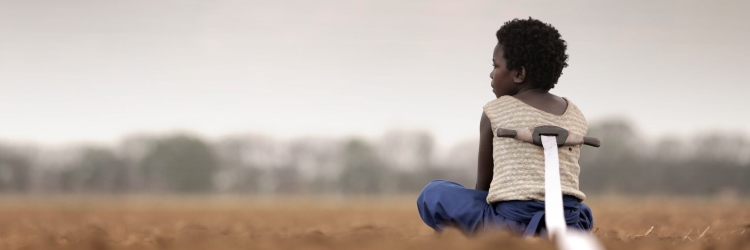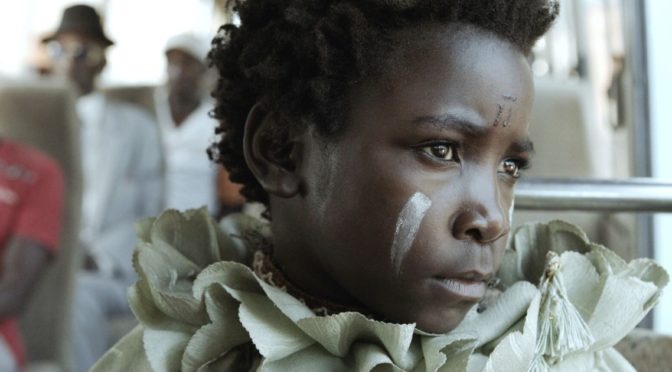The debut feature film from director Rungano Nyoni, I AM NOT A WITCH tells the story of a young girl who is accused of witchcraft by the denizens of her small Zambian town. Exiled to a witch camp, she and her fellow supposed witches are kept in confinement by a long ribbon tied to each of their backs that, if broken, will allegedly turn them into a goat.
Nyoni’s tale begins with nine-year-old Shula (Maggie Mulubwa), a quietly stoic girl dressed in a “#bootycall” t-shirt being taken to the local police precinct, where half of the town turn out to proclaim her a witch. The farce-tinged opening is more than a little reminiscent of the witch scene in MONTY PYTHON AND THE HOLY GRAIL. That comparison is reinforced by a town member who, channelling John Cleese and his tall tales of being transformed into a newt, spins a yarn to the bored and unimpressed police officer about Shula cutting off his arm with an axe, before meekly admitting to it being a dream when the officer glances sceptically at his arms, both of which are completely, stubbornly, intact.
This coupling of mundanity and absurdity very much sets the stage for what Nyoni intends to accomplish with the rest of I AM NOT A WITCH, including the intentional ambiguity over whether or not magic exists in this world, and if Shula truly is a witch. Despite the unconvincing testimonies, Shula is palmed off to an opportunistic local government official, Mr Banda (Henry BJ Phiri), and exiled to a local witch camp, where she is hooked up to a large spool of ribbon, and told that if she breaks it, she will be turned into a goat, and unlike John Cleese, she will not just get better.

…Nyoni spent time in real life witch camps in Ghana and Zambia, and this endeavour for authenticity shines…
While researching for this screenplay, Nyoni spent time in real life witch camps in Ghana and Zambia, and this endeavour for authenticity shines in the scenes that introduce and explore Shula’s new home. Populated entirely by old women with smatterings of white paint on their faces, the witch camp is an exercise in showing how the fantastical can be normalised. The fairy tale nature of the magical white ribbons that keep witches tethered so they can’t fly off in the night is forced into the mundane here. The witches themselves work the land for the local chieftain and sit patiently like animals in a zoo exhibit while tourists gawk and snap pictures – less magical beings and more inconvenient parts of the furniture.
The scenes between Banda and Shula capture the charm of I AM NOT A WITCH…
That’s not to say that Nyoni doesn’t weave a sense of the surreal into the satire, and much of her examination of the misogyny and superstition that led the witches to their camp focuses on the presence or lack of magic. These moments are presented with a deadpan air of absurdity, at once hilarious for their ridiculousness, and troubling for what they represent, such as the witch doctor called in to confirm that Shula is a witch taking off his clothes to prove that he is the real deal, like a birthday party magician rolling up his sleeves. The scenes between Banda and Shula capture the charm of I AM NOT A WITCH, with the mismatched double act of the exuberant and expressive Phiri and the more muted, quietly determined Mulubwa delivering a magic of its own.
Helped along by a sporadically used, yet satisfyingly whimsical soundtrack, and starring an eclectic mix of family members, non-professional actors and the newly discovered talent of Mulubwa, I AM NOT A WITCH is an atmospheric and satirical slow-burn that blends reality with just enough fantastical superstition to lead nicely into the understated finale, which caps the film off with a trademark mix of comedy, tragedy, and magic.

